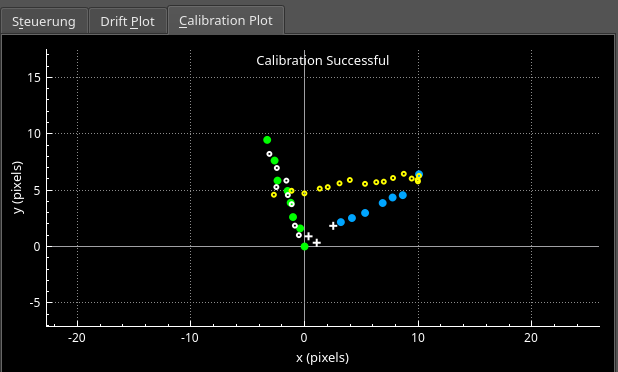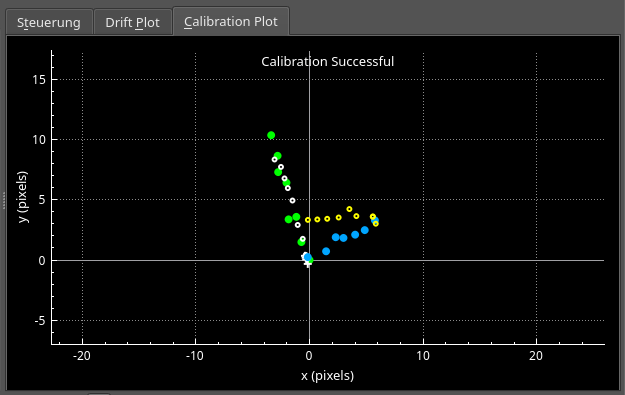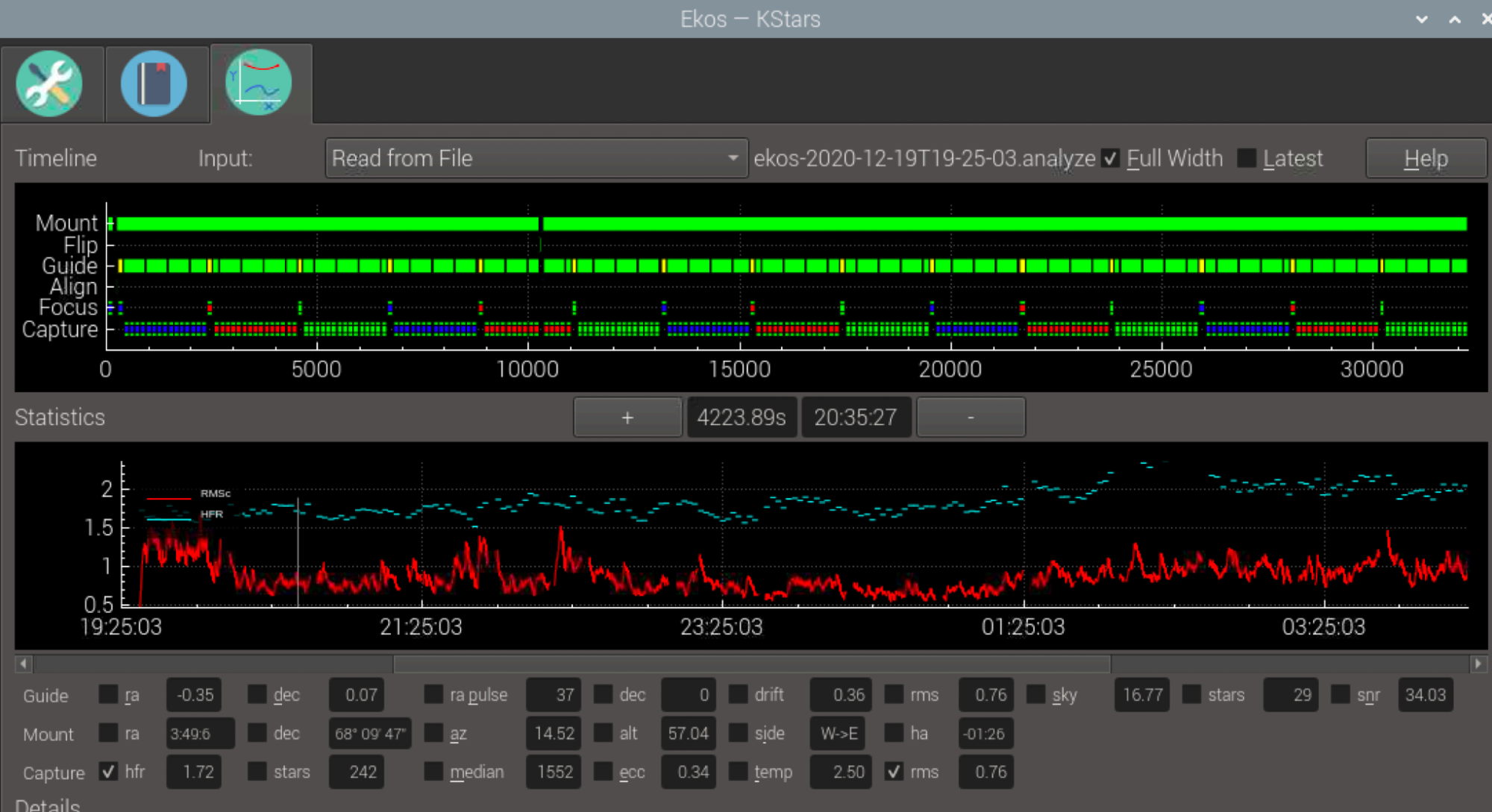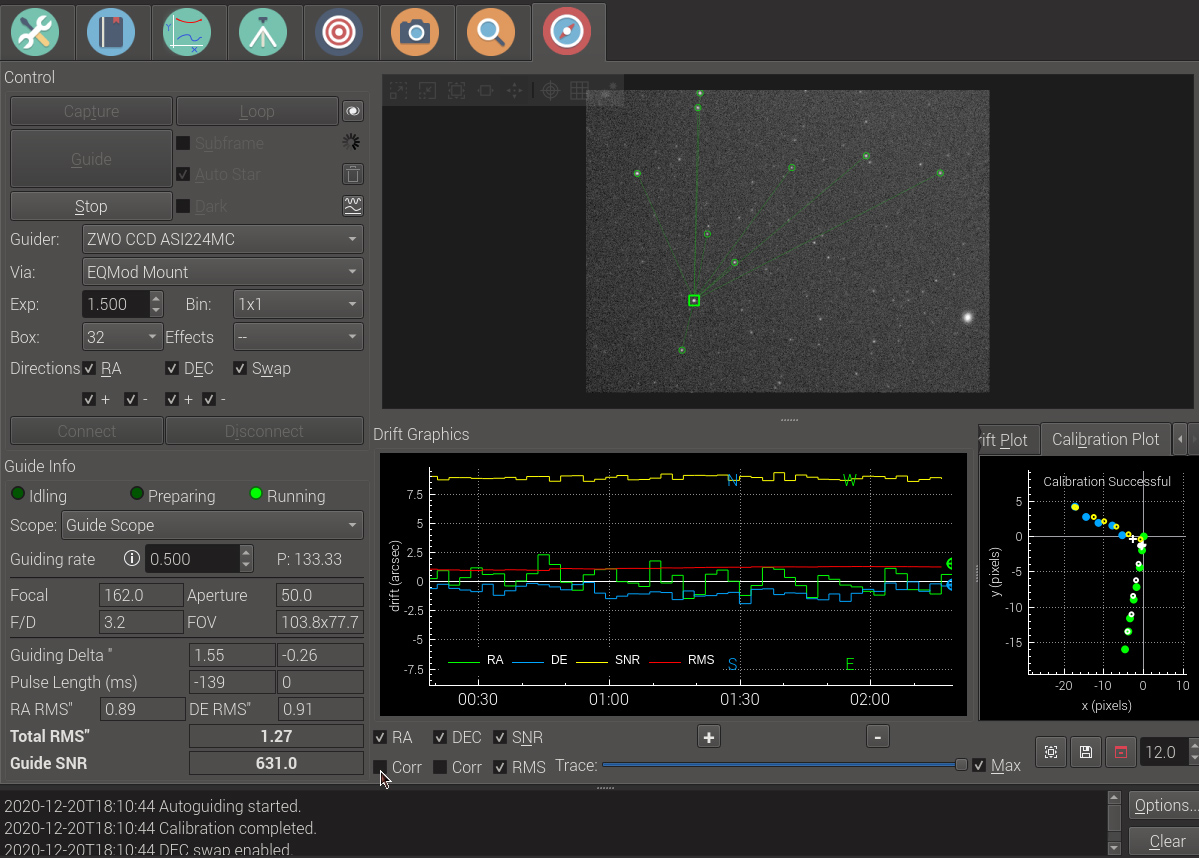INDI Library v2.0.7 is Released (01 Apr 2024)
Bi-monthly release with minor bug fixes and improvements
Calibration Plots of different mounts - unmodified or modified
If a user knows how well a mount performs in guiding then she or he can buy a good mount which is worth the money.
I own a cheap Skywatcher HEQ 5 Pro and I want to share the Calibration Plot which drives me mad.
With this mount I get a Total RMS" in the range from 0.95" to 3.3"
I am using the Internal Guider. In the past PHD2 refused to accept the calibration procedure.
If we can build up some kind of "database" and are able to compare the calibration plots of different mounts (modified or not) maybe we can avoid products which are not up to the task.
Please add your mount, we all need to get more information!
Clear skies!
GNU / Linux
Git
KDE neon
KStars | EKOS | INDI
and some cheap hardware
Please Log in or Create an account to join the conversation.
- maxthebuilder
-
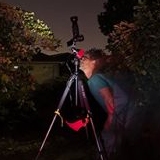
- Offline
- Platinum Member
-

- Posts: 912
- Thank you received: 86
Replied by maxthebuilder on topic Calibration Plots of different mounts - unmodified or modified
My calibration looks better in RA but the total RMA is still about the same. On a good night with really good skies (I am in Bortle 8 ) I get total RMS around 1.
ZWO AM5. RST-135. AZ-GTI. HEQ5. iOptron SkyTracker.
TPO RC6. FRA400. Rokinon 135 and other lenses.
ZWO ASI2600MC. D5500 modified with UVIR clip-in filter.
ZWO ASI120MM Mini x 2. ZWO 30F4 guider. Orion 50mm guider.
ZWO EAF x 3.
Please Log in or Create an account to join the conversation.
Replied by Heiko on topic Calibration Plots of different mounts - unmodified or modified
And yes indeed, the quality of the guiding depends, I think mostly on good seeing. In think that my polar alignment is quite good because I use the PoleMaster.
The author Covington writes in his book 'Digital SLR Astrophotography' that a RMS error of 0.5" is exceptional, 1" is very good, 1.5" is good and 2" is acceptable when the seeing is bad or you use a cheap setup.
But the misshaped dec-axis concerns me most. I think my mount has some severe mechanical issues, I assume a bent worm shaft. This is the reason why I am uncertain if a Skywatcher EQ6-R Pro shows a better calibration plot.
In the userguide of PHD2 they state that the axes should be perpendicular to each other. This is probably the reason why PHD2 is not able to calibrate my setup.
GNU / Linux
Git
KDE neon
KStars | EKOS | INDI
and some cheap hardware
Please Log in or Create an account to join the conversation.
Replied by Doug S on topic Calibration Plots of different mounts - unmodified or modified
So, all this said, I've gotten reasonably good images from the mount as can be seen in my new AstroBin page. I attach my calibration (phd) for reference.
Cheers, Doug
www.astrobin.com/users/dmsummers/
Please Log in or Create an account to join the conversation.
Replied by Heiko on topic Calibration Plots of different mounts - unmodified or modified
Of course it is! Thank you for sharing, the plot seems almost perfect to me.
I will try to "admire" this part of the hobby
GNU / Linux
Git
KDE neon
KStars | EKOS | INDI
and some cheap hardware
Please Log in or Create an account to join the conversation.
- Hy Murveit
-
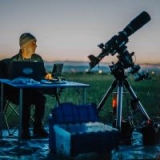
- Away
- Administrator
-

- Posts: 1221
- Thank you received: 565
Replied by Hy Murveit on topic Calibration Plots of different mounts - unmodified or modified
and the outgoing sections are what's used for calibration. I'm not sure why the DEC return portion does that odd return, but it does that for me too. My guiding is a little
better than you mention--but not that different (using the RMS in Analyze) when using GPG (dec usually < .5, RA usually .7-.9 or so) in Silicon Valley.
Here's my run from last night (7:30pm to 4:30am with a meridian flip around 10:15pm) as shown in Analyze (plotting RMS and image HFR).
You can see that, during the best parts of the night, between 11pm to 1:30am, it seemed to have an RMS in the .6 or .7 range, but later on it was pretty close to 1.0.
I assume this has to do with sky conditions more than mount, but not 100% sure. The image HFRs get worse with the worse guiding.
I don't tend to calibrate much. I've used the PHD2 advice of calibrating "well" once and then re-using the calibration, and this seems to work well
for me in KStars. (I added the capability to reuse calibrations in KStars several months ago).
Honestly, though I wish the calibration plots looked better, that weird (yellow) line is the DEC return, and my DEC guiding is quite good, I believe, so it doesn't concern me much.
Also, if you haven't noticed, if you click the options button on the Guider tab, and then click on the Calibration section, the actual angles
calculated for RA and DEC are printed, so you can see how close to 90 degrees yours are.
Hy
Please Log in or Create an account to join the conversation.
Replied by Heiko on topic Calibration Plots of different mounts - unmodified or modified
Your explanations as one of the maintaining developers of the analyze
part of the source code are very useful.
It is comforting to read that the Dec return axis of the plot does not
effect the actual guiding so much.
The charts in the Statistics section of the Analyzer Tab give a good overview. It
would be terrific if the underlying data could be further analyzed by Kstars
which could report its finding (e.g. misalignment, mechanical issues pp) back to the user.
You are right, I was not aware of the calculated angles in the
Calibration section.
Would you advise to calibrate once in a while
with the guide star standing near the intersection of the meridian and
the celestial equator and re-use this calibration?
GNU / Linux
Git
KDE neon
KStars | EKOS | INDI
and some cheap hardware
Please Log in or Create an account to join the conversation.
- Hy Murveit
-

- Away
- Administrator
-

- Posts: 1221
- Thank you received: 565
Replied by Hy Murveit on topic Calibration Plots of different mounts - unmodified or modified
Would you advise to calibrate once in a while
with the guide star standing near the intersection of the meridian and
the celestial equator and re-use this calibration?The charts in the Statistics section of the Analyzer Tab give a good overview. It
would be terrific if the underlying data could be further analyzed by Kstars
which could report its finding (e.g. misalignment, mechanical issues pp) back to the user.Please Log in or Create an account to join the conversation.
- Jose Corazon
-

- Offline
- Supernova Explorer
-

- Posts: 1119
- Thank you received: 182
Replied by Jose Corazon on topic Calibration Plots of different mounts - unmodified or modified
Correct me if I'm wrong here, but I think that only applies if you rotate your guide cam. It should have no effect if you rotate your imaging camera, because whatever that sensor is seeing will not affect what the guide cam is seeing (unless you are using an OAG).
Here my calibration plot from tonight, using a CEM25P mount, so very low end, with a ZWO guide scope of only 120mm focal length and an ASI120MM-S as guide cam. I don't think one can get more basic than this.
I think calibration is pretty good and RMS of 1" is about what one can expect from the mount and the short focal length guide cam.
Please Log in or Create an account to join the conversation.
- Hy Murveit
-

- Away
- Administrator
-

- Posts: 1221
- Thank you received: 565
Replied by Hy Murveit on topic Calibration Plots of different mounts - unmodified or modified
Hy
Please Log in or Create an account to join the conversation.
- maxthebuilder
-

- Offline
- Platinum Member
-

- Posts: 912
- Thank you received: 86
Replied by maxthebuilder on topic Calibration Plots of different mounts - unmodified or modified
ZWO AM5. RST-135. AZ-GTI. HEQ5. iOptron SkyTracker.
TPO RC6. FRA400. Rokinon 135 and other lenses.
ZWO ASI2600MC. D5500 modified with UVIR clip-in filter.
ZWO ASI120MM Mini x 2. ZWO 30F4 guider. Orion 50mm guider.
ZWO EAF x 3.
Please Log in or Create an account to join the conversation.
Replied by Heiko on topic Calibration Plots of different mounts - unmodified or modified
@maxthebuilder
Your mounts, although being low-end, perform pretty well.
You both use SEP Multi Star (recommended) as the guiding algorithm, I suppose?
Which of the 5 SEP Profiles was chosen?
I have to recognize that your stars in the frame from your guidecams
are round. For me, this is not the case. They look like three point
shuriken. I use a ZWO ASI290MM Mini and an Omegon guidescope with an
aperture of 60 mm and a focal length of 240 mm. I wonder if this
impairs my guiding?
GNU / Linux
Git
KDE neon
KStars | EKOS | INDI
and some cheap hardware
Please Log in or Create an account to join the conversation.

